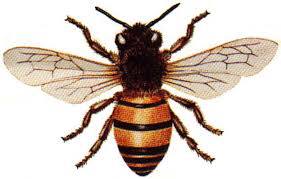 photo courtesy beneficialbugs.org
photo courtesy beneficialbugs.org
 my all-time favorite “live” bee picture from Cindy Houlihan in Italy! thank you Cindy!
my all-time favorite “live” bee picture from Cindy Houlihan in Italy! thank you Cindy!
(George just said I am like Erin Brockovich!)
Ok, so Christin got up this morning and told me the story (I actually missed it – how did that happen?) that she read on Twitter about the memorial service for the 50,000 bees killed by the pesticide, Safari in Oregon, and did I see it? I am actually happy because now I have Christin’s “antenna up” on the bee issue! (no pun intended) My campaign is working – I have one person “attracted”!
Anyway, since I am sincerely interested in this issue, and now incensed about the inaction – (several European countries are ahead of us in dealing with problems and in fact banned the class of pesticides known as neonicotinoids for two years on 4/29 – http://www.motherjones.com/tom-philpott/2013/05/eu-ban-bee-harming-pesticides-puts-pressure-us-epa) and it seems so counter-intuitive to me in my own naive way that this is really happening right in front of our faces.
Here is my principal question: Now that they have first hand evidence that these pesticides kill bees, almost instantaneously, what could possibly be standing in the way of the EPA in banning them from use in the US immediately? But, I have other questions as well……..
Could I actually illustrate the effects of the following problems precisely?:
- lobbying in Washington by pharma and chem companies
- the quagmire of bureaucracy which, due to inefficiency, incompetence, and/or blatant negligence, inhibits health and well-being of citizens, including a most beneficial creature, critical in the food chain and in ensuring profits to millions of farmers, food distributors, the hospitality industry, and feeds the population of our planet
- the push-pull of profits vs health
- failure to identify horrific “collateral damage” of pesticide use
- dragging feet to act, failure to deal with data which is direct proof; failure of legislation to allow for up front banning or quarantine of pesticides which are only in the “suspected” category and in this case, proven to have killed the bees
and so, I decided to do a little experiment:
I decided to personally see how the EPA works, or doesn’t work. I guess I just decided to see how user-friendly our government is……….. Oh boy, am I about to be seriously (more seriously) disillusioned? Anyway, I think it is worthwhile to look into this. Here is what I have done so far today:
- read the story about the bee killing and how the Dept of Agriculture in Oregon has indeed confirmed that this pesticide did kill the bees
- looked the pesticide up online and found the manufacturer and its marketing page – featuring quick “knock-down” as one of it major benefits
- started tracking down information on the EPA – found it’s current “acting” Administrator, Bob Perciascepe
- found a contact number for the EPA, called the number 202-564-4711, got through easily at 8:02 am today, and was promptly transferred three times to:
- one Arthur Elkins or his assistant at 202-566-0847, the office of investigations,
- and finally spoke to a man named Allen Williams in the Inspector General’s office; I tried to explain why I was calling without sounding like some crazy nut: I said I was just trying to find out how these things are handled and what was being done about this class of insecticides; he took my name and number and promised to have someone from the Hotline area call me back; I asked him if he was going to have the IRS investigate me? (haha) so if you never hear from me again you should suspect our government (haha????) are they going to get the NSA after me? next time I try to fly, we’ll see what happens (I’ll be on the detainees list)!
- looked online to try to find the Hotline number myself; found regional numbers- (I didn’t think to ask him) so I could change the phone number on my facebook post
- tried to find contact information on Christie Whitman – thought I should reach out to her to see if she might help
- it’s now 12 noon – no call back yet; it is now 3:37 no call back yet (surprised?)
- and so, you too can call the EPA, however which way you’d like, to ask what is being done about this class of pesticides called neonicotinoids
****************************************************************************************************
Here is some background on the current issue:
Info on Safari – directly from the manufacturer’s website:
Safari Insecticide. Where the wild things aren’t.
Safari Insecticide, a super-systemic insecticide with quick uptake and knockdown, controls a broad spectrum of ferocious and invasive pests, including Q- and B-biotype whitefly, Hemlock woolly adelgid, emerald ash borer, mealybug, mountain pine beetle 2(ee), leafminer, fungus gnat, black vine weevil, glassy-winged sharpshooter, armored and soft scale and lacebug—some of the most costly pests that affect high value greenhouse and nursery crops such as poinsettia and hibiscus, as well as trees, shrubs and herbaceous ornamentals in the lawn and landscape market. With two formulations, Safari is super-flexible when it comes to application.
following is courtesy of : http://www.antigmofoods.com/2013/06/more-than-50000-bees-killed-in-oregon.html?showComment=1372208411809
Monday, June 24, 2013
More than 50,000 bees killed in Oregon, insecticide blamed in largest bee die-off in recorded history
- Over 300 wild honeybee colonies have been wiped out
- Bee genocide took place during ‘National Pollenator Week,’ a commemoration of bees
- Officials are investigating whether the insecticide application broke any local or state laws
Scientists may have discovered how more than 50,000 bees suddenly died this week in an Oregon parking lot.
Locals became alarmed when tens of thousands of honeybees started dropping like flies at a local strip mall parking lot, a subsequent investigation has discovered a pesticide sprayed on over 50 trees to kill aphids instead resulted in what experts allege is the largest single bee die-off in recorded history.
‘This is a big mistake, somebody really screwed up,’ Mace Vaughn, of the Xerces Society, a local organization that works to protect bees, told KGW.
Even worse, the bees were killed, according to KATU, during ‘National Pollenator Week,’ a week aimed at celebrating the vital role the honeybee plays in our ecosystem.
Valent, the insecticide’s manufacturer, calls it’s toxic brew ‘super systemic’ and proudly claims that it’s ‘where the wild things aren’t’ on its website. The site claims that Safari is ‘clocked as the fastest broad spectrum insecticide on the market,’ saying that it’s ‘quick uptake and knockdown’ is effective against several bugs including ash borers, mealybugs, pine beetles and other invasive pests known to destroy high value greenhouse and nursery crops.Valant may as well add honeybees to the list as well, as this is not the first incident of the toxin killing them off in mass quantities, according to media reports.
This incident is just the latest in a series of bee die-offs that has resulted in the decimation of 31% of the US’ bee population in 2012 alone, according to the Guardian. The large-scale erosion of bee populations, attributed mainly to ‘colony collapse disorder,’ poses a series threat to the food supply and the economy – bees contribute $20 billion to national economy.
Oregon officials are working to determine whether the application of Safari was in violation of any state or local laws,
Current update:
via KOIN.com:
On Thursday, June 27 the State of Oregon took emergency action “restricting use” of 18 pesticide products containing the active ingredient dinotefuran while it continues the investigation. The State of Oregon stepped in and banned the offending pesticide for six months. The Linden trees sprayed in the Target parking lot in Wilsonville, Oregon have been wrapped. The trees were apparently sprayed at the wrong time of day and when in full bloom, thereby attracting the bees to them.
More to come on this topic.
I will continue to report on my progress with the EPA. Please stay tuned and visit my new Facebook page, called “On Behalf of Bees” where I will attempt to keep a good chronicle of what is going on with the EPA and the marketers of these chemicals and the state government’s progress as well.
 photo taken Wednesday in Mendham, NJ
photo taken Wednesday in Mendham, NJ
